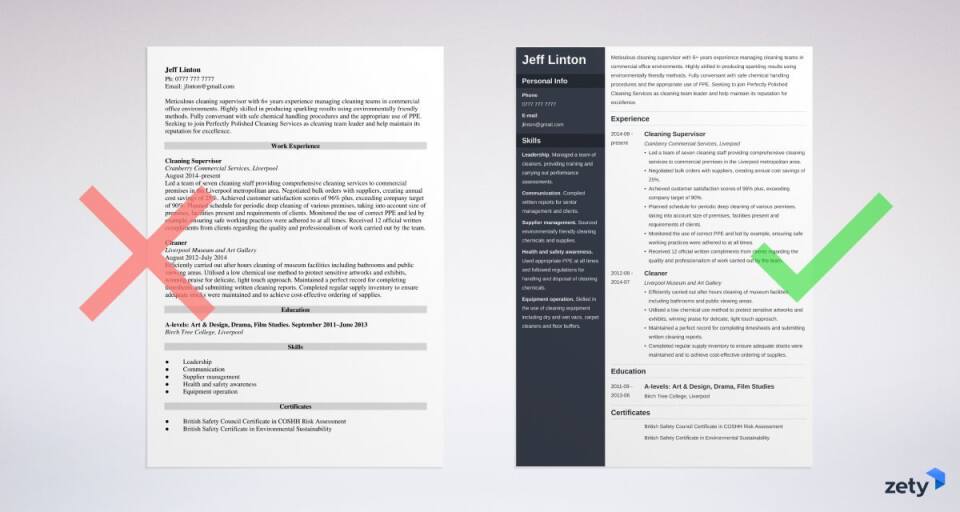What Makes a Good CV in the UK? (+ Examples)
Create your CV nowWhat makes a good CV? Fortunately, the answer to how to write a good CV is much easier than you would assume. You just need to know what to pay attention to, and the entire writing process will be quick and easy!
To help you out, I've also prepared some good CV examples, so you can check out what a great CV should look like. Without further ado, let's begin!
Want to save time and have your CV ready in 5 minutes? Try our CV builder. It’s fast and easy to use. Plus, you’ll get ready-made content to add with one click. See 20+ CV templates and create your CV here.
Sample CV made with our builder—See more CV examples here.
Good CV example #1
Jeff Linton
Cleaning Supervisor
070 2505 3590
jlinton@email.com
Meticulous cleaning supervisor with 6+ years experience managing cleaning teams in commercial office environments. Highly skilled in producing sparkling results using environmentally friendly methods. Fully conversant with safe chemical handling procedures and the appropriate use of PPE. Seeking to join Perfectly Polished Cleaning Services as a cleaning team leader and help maintain its reputation for excellence.
Work Experience
Cleaning Supervisor
Cranberry Commercial Services, Liverpool
August 2022–October 2024
Key Qualifications & Responsibilities
- Led a team of seven cleaning staff providing comprehensive cleaning services to commercial premises in the Liverpool metropolitan area.
- Achieved customer satisfaction scores of 96% plus, exceeding the company target of 90%.
- Planned schedule for periodic deep cleaning of various premises, taking into account the size of premises, facilities present, and requirements of clients.
- Monitored the use of correct PPE and led by example, ensuring safe working practices were adhered to at all times.
- Received 12 official written compliments from clients regarding the quality and professionalism of work carried out by the team.
Key Achievement:
- Negotiated bulk orders with suppliers, creating annual cost savings of 25%.
Cleaner
Liverpool Museum and Art Gallery
August 2020–July 2022
Key Qualifications & Responsibilities
- Efficiently carried out after-hours cleaning of museum facilities, including bathrooms and public viewing areas.
- Maintained a perfect record for completing timesheets and submitting written cleaning reports.
- Completed regular supply inventory to ensure adequate stocks were maintained and to achieve cost-effective ordering of supplies.
Key Achievement:
- Utilised a low chemical use method to protect sensitive artworks and exhibits, winning praise for the delicate, light-touch approach.
Education
A-levels: Art & Design, Drama, Film Studies
September 2018–June 2020
Birch Tree College, Liverpool
Skills
- Leadership: Managed a team of cleaners, providing training and carrying out performance assessments.
- Communication: Compiled written reports for senior management and clients.
- Supplier management: Sourced environmentally friendly cleaning chemicals and supplies.
- Health and safety awareness: Used appropriate PPE at all times and followed regulations for handling and disposal of cleaning chemicals.
- Equipment operation: Skilled in the use of cleaning equipment, including dry and wet vacs, carpet cleaners, and floor buffers.
Certificates
- British Safety Council Certificate in COSHH Risk Assessment
- British Safety Certificate in Environmental Sustainability
Good CV example #2
Alexandra Kelly
Marketing Manager
070 5501 6300
alexandrakelly@email.com
linkedin.com/in/alexandrakelly
Summary
Strategic and results-oriented Marketing Manager with 7+ years of experience in developing and executing marketing campaigns that drive brand growth and engagement. Eager to support Apex Solutions in achieving higher visibility and customer retention through data-driven strategies. Proven track record in managing teams and budgets and delivering significant revenue growth, including a successful product launch that generated £1.3M in the first quarter.
Experience
Marketing Manager
Star Global Solutions, London, UK
June 2022–September 2024
Key Qualifications & Responsibilities
- Led a team of 8 marketing professionals across digital, social, and traditional channels.
- Managed a £450,000 annual marketing budget, optimizing resource allocation for maximum impact.
- Increased brand visibility by 30% through content marketing and influencer collaborations.
- Developed data-driven marketing strategies, resulting in a 25% increase in lead generation.
Key Achievement:
- Spearheaded a product launch that generated £1.3M in revenue within the first quarter.
Marketing Coordinator
Elite Corporation, Manchester, UK
July 2017–May 2022
Key Qualifications & Responsibilities
- Coordinated cross-channel campaigns, focusing on email marketing and social media.
- Assisted in the execution of an annual marketing plan, contributing to a 15% revenue increase.
- Managed relationships with vendors, saving 10% on marketing expenditures.
Key Achievement:
- Boosted website traffic by 20% through engaging content and improved customer engagement.
Education
Master of Business Administration (MBA), Marketing
University of Manchester, UK
2015–2017
Bachelor of Arts in Marketing
University of Leeds, UK
2012–2015
Skills
- Digital Marketing: Managed and optimized campaigns across SEO, PPC, and social media platforms to drive brand awareness and lead generation.
- Brand Strategy & Positioning: Developed and executed brand strategies to strengthen market presence and align with business objectives.
- Data Analysis & CRM: Utilized HubSpot and Salesforce to analyse customer data and refine marketing strategies for improved engagement and retention.
- Campaign Management: Led multi-channel marketing campaigns, ensuring timely execution and measurable outcomes.
- Leadership & Team Development: Managed and mentored a team of 8 marketing professionals, fostering skill development and high performance.
- Budget Management & ROI Optimization: Managed a £450,000 marketing budget, ensuring cost-effective allocation and a 25% increase in ROI.
- Content Creation & Copywriting: Created compelling content for digital platforms, improving website traffic and customer engagement.
Certifications
- Google Analytics Certified, Google, 2023
- HubSpot Inbound Marketing Certification, HubSpot, 2022
Languages
- English—Fluent
- Polish—Native
- German—Conversational
Interests
- Blogging about digital marketing trends
- Attending marketing conferences and webinars
- Volunteer content creation for non-profits
Now that you’ve seen some outstanding CV examples, it’s time that I show you what makes a good CV.
What makes a good CV stand out?
1. It’s up-to-date
A good CV is always up to date. Be super diligent about checking all the dates and contact information. After all, you don’t want to miss a job opportunity just because you forgot to update the phone number on your CV!
Here’s what to include in a good CV header:
- Full name
- Phone number
- Email address (but make sure it sounds professional)
- LinkedIn profile or a link to your website
Read more: How to Include Your CV Personal Details
2. Perfect formatting
Nothing makes the recruiter’s life easier than a well-formatted CV that’s quick to scan. Recruiters are really short on time as they take only 7.4 seconds to scan a CV initially. Pick a good CV format that will suit your needs best:
- Reverse-chronological format: it’s the most popular CV format and recruiter’s favourite. It should suit you well if you have some professional experience.
- Functional format: consider it when you’re just starting out on your professional journey or going after an entry-level job.
- Combination format: it’s pretty rare but it’s perfect for career changers who want to highlight their transferable skills.
No matter what CV format you choose, here are some design tips to make your CV look good:
- Margins: set margins to 1 inch on all sides.
- Font choice: opt for professional, good CV fonts like Arial, Helvetica, Georgia, or Times New Roman.
- Font size: use 14–16 pt for section headers and 12 pt for the main body text.
- Formatting: use bold for emphasis but sparingly. Underline section headers for clear separation, and use italics for secondary details like locations.
- Length: aim for a one-page CV, though two pages are acceptable for highly experienced or senior candidates.
Read more: Different CV Formats
3. Impressive CV profile
No example of a good CV can go without the ultimate magnet for recruiters’ attention—a well-crafted CV profile, aka CV summary. The details of writing this short introduction to your CV depend on how experienced you are. No matter if you’re a rookie or a true pro, you should briefly highlight who you are as a professional, what can you offer to the employer, and what are your career goals.
But that’s not all.
If you're an experienced professional, here's what to do to make a good CV intro: Begin by listing your key strengths, including the skills and experience that demonstrate your ability in the field. Next, review the job description and pick out 3–4 points that align with your own qualifications. Use these to craft a tailored CV summary that highlights how your experience matches the specific needs of the position you're applying for.
But—if you're at the beginning of your career and have little to no experience, take a different approach. Focus on your skills and experience, emphasising your education and any relevant practical experience, even from unrelated jobs. Combine this with your enthusiasm for the role and an understanding of the employer's needs to show you're a strong candidate.
Read more: How to Write a CV Profile: Examples and Tips
4. Relevant work experience
Another thing that makes a good CV is that it’s relevant to the job offer. Especially in terms of experience. You don’t have to list everything you’ve ever done unless you want to bore the recruiter to death.
To create a standout CV, your work experience section needs to be spot on, clearly showing your qualifications for the role. Follow these steps:
- Start with your most recent position and work backward.
- List your current job title or position.
- Include the company name and its location.
- Use bullet points to outline your key responsibilities—limit it to six for your current role, with fewer for past jobs, keeping descriptions concise.
- If applicable, add key achievements (1–3), selecting those that are the most impressive.
- Use action verbs to highlight your active role in each job.
- If you've been promoted, make sure to note that, and group multiple roles at the same company.
One last thing: all good CVs rely on the power of numbers. That’s why you should quantify your achievements whenever possible to make your CV truly impressive.
Read more: How to Add Work Experience to a CV
5. Neat education section
It might be tempting to gloss over it, but what’s true for other CV sections, is valid also for this one—a good education section contributes to a good CV.
Here’s what you should include:
- Degree
- The school’s name and location
- Graduation date (and if you’re still studying, the expected date of graduation)
Got a lot of experience? List only your last degree. If you’re just starting out, add some relevant details such as relevant coursework and more.
Read more: What to Include in Your CV Education Section
6. Skills that the employer actually needs
What makes a good CV? Certainly not listing all the skills you can think of. Just like with presenting your experience, relevance is key to writing a good CV. But—many candidates mistakenly think that cramming their CV with an extensive list of every skill imaginable will make it stand out. Don’t be one of them.
Here’s how to make a good CV skills section:
- Keep a balance between hard skills and soft skills, as they’re equally valuable.
- Reread the job offer to identify the key skills the company needs.
- Highlight these skills in the skills section of your CV, but ensure you're honest—don’t claim skills you don’t have.
- Be specific when listing skills, especially since applicant tracking systems (ATS) scan for keywords. For example, if the ad mentions 'Microsoft Word,' don’t just list 'Office'—otherwise, you may be overlooked.
Read more: How to List Your Skills on a CV
7. Additional CV sections
What makes a good CV truly stand out from the thousands of other job applications? A strategic use of carefully curated extra CV sections. Here are some you can add to your CV:
- Hobbies and Interests—picking generic hobbies like "reading" or "watching movies" won’t make a good CV. Instead, choose interests related to the job. For example, when targeting a tech role, mention "coding personal projects" or "participating in hackathons." For marketing, highlight "writing a blog on digital trends." Tailoring your hobbies and interests helps demonstrate relevant skills, especially if you’re new to the industry.
- Certificates and Licenses—this section allows you to highlight any relevant courses, certificates, or awards. They can give you an edge over other candidates. Simply list the certificate or course name and the year you obtained it.
- Volunteer Work—volunteer experience is often overlooked by candidates, both experienced and inexperienced. However, it shows that you care enough about something to dedicate your free time to it. This section is especially useful if you have limited job experience, as it can demonstrate skills, professionalism, and maturity.
- Foreign Languages—fluency in foreign languages can make you a top candidate for many positions. List each language and your level of proficiency. Depending on where you're applying, choose the most appropriate proficiency scale to indicate your skill level.
Read more: CV Writing Tips & Expert Advice [+ Examples]
Making a CV with our builder is incredibly simple. Follow our step-by-step guide, use ready-made content tailored to your job and have a CV ready in minutes.
When you’re done, Zety’s CV builder will score your CV and tell you exactly how to make it better.
8. Matching cover letter
Yes, I know that we’re analysing what makes a good CV, and it seems like a cover letter is an entirely different matter (rhyme intended). But—a good CV can become even more powerful if it’s accompanied by even a short cover letter. Need data to convince you? 83% of hiring managers view cover letters as important. If this stat doesn’t convince you, then I don’t know what will!
Read more: How to Write a Cover Letter
9. Proofreading
You put a lot of effort into writing your CV, so don’t risk falling for a mistake that can break it. Poor grammar or spelling will make the recruiter think that you lack attention to detail, and what’s worse—they’ll assume that you simply don’t care.
No good CV was ever made without proofreading. Here are some tips to help you out:
- Use tools like Grammarly or built-in spell checkers to spot mistakes.
- Reread your CV slowly and out loud to catch errors you might miss.
- Have someone qualified review your CV for feedback.
Read more:Proper CV Layout
10. Honesty
This should be pretty obvious, but lying on a CV is always a bad idea. Misrepresenting your skills or experience can get you hired for a role you're not qualified for, which can harm both your career and the company.
Plus, employers often verify information even after you get the job, and any false claims could result in getting fired or damaging your professional reputation. A truthful CV demonstrates integrity and ensures you're a genuine fit for the position.
Read more: Lying on a CV: Is It a Good Idea?
Plus, a great cover letter that matches your CV will give you an advantage over other candidates. You can write it in our cover letter builder here. Here's what it may look like:

See more cover letter templates and start writing.
Key takeaway
Maybe you thought that making a good CV must be hard work. But—it can be easy as long as you remember what makes a good CV:
- Using a CV format best suited to your situation
- Filling it with up-to-date and relevant experience and skills
- Attaching an impactful cover letter that will wow the recruiter
- Proofreading and editing
- Sticking to the truth
- Making your CV aesthetically pleasing
- Adding some extra CV sections
Now that you have everything you need to make a good CV, start writing! But before you do that, you can reach out to me in the comments section. I’ll be happy to help you out with the details of what makes a good CV and more!
About Zety’s Editorial Process
Our editorial team has thoroughly reviewed this article to ensure it follows Zety’s editorial guidelines. Our dedication lies in sharing our expertise and providing you with actionable career advice that offers you real value. Every year, the quality of our content attracts 40 million readers to our site. But that’s not all – we conduct original research to gain a detailed understanding of the labour market. We take pride in being cited by top universities and leading media outlets in the UK and worldwide.





